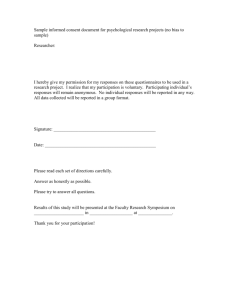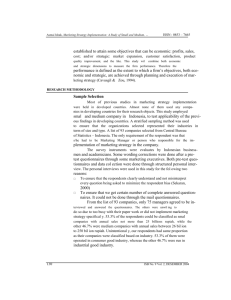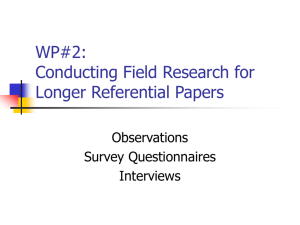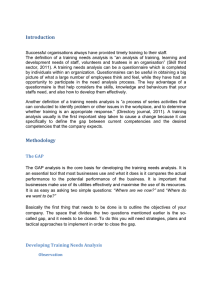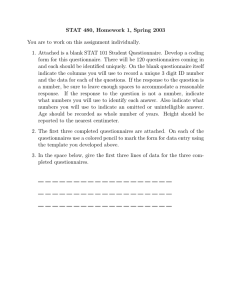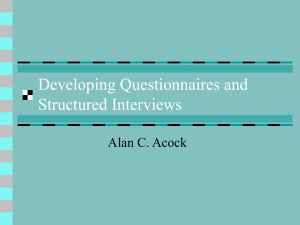Sumber :
advertisement
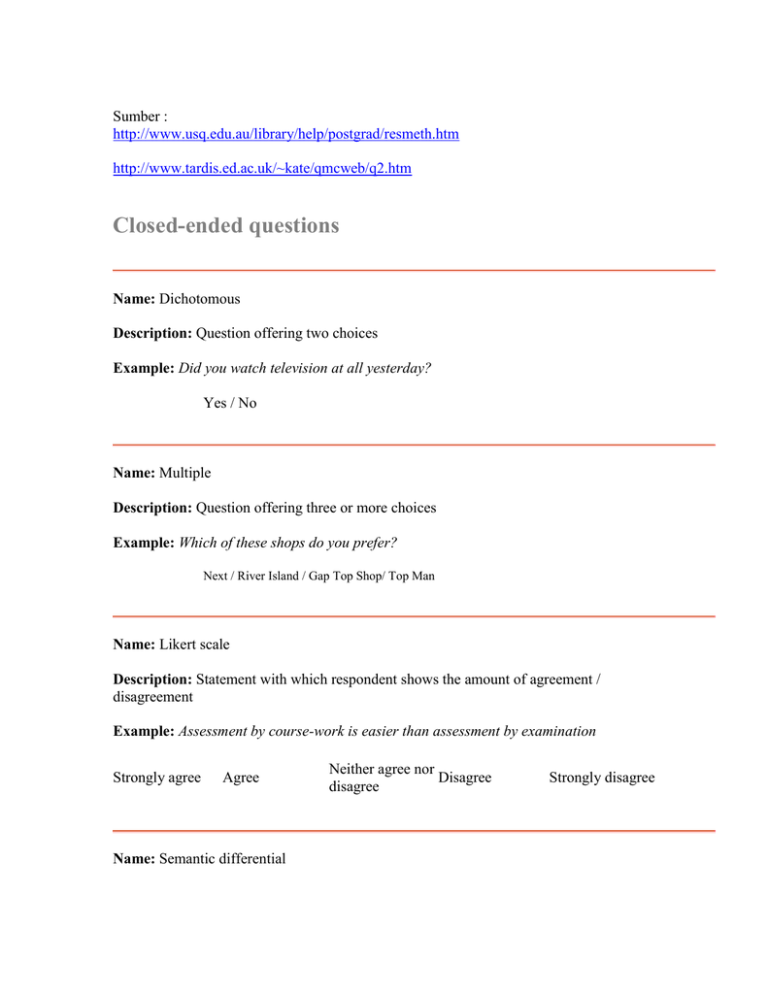
Sumber : http://www.usq.edu.au/library/help/postgrad/resmeth.htm http://www.tardis.ed.ac.uk/~kate/qmcweb/q2.htm Closed-ended questions Name: Dichotomous Description: Question offering two choices Example: Did you watch television at all yesterday? Yes / No Name: Multiple Description: Question offering three or more choices Example: Which of these shops do you prefer? Next / River Island / Gap Top Shop/ Top Man Name: Likert scale Description: Statement with which respondent shows the amount of agreement / disagreement Example: Assessment by course-work is easier than assessment by examination Strongly agree Agree Name: Semantic differential Neither agree nor Disagree disagree Strongly disagree Description: Scale is inscribed between two bipolar words and respondent selects the point that most represents the direction and intensity of his / her feelings Example: The degree I am taking is............. Interesting :_____:_____:_____:_____:_____:_____:_____: Boring Useful :_____:_____:_____:_____:_____:_____:_____: Useless Easy :_____:_____:_____:_____:_____:_____:_____: Difficult Name: Rank order Description: Respondent is asked to rate or rank each option that applies. This allows the researcher to obtain information on relative preferences, importance etc. Long lists should be avoided (respondents generally find it difficult to rank more than 5 items) Example: Please indicate, in rank order, your preferred chocolate bar, putting 1 next to your favourite through to 5 for your least favourite. Double Decker Crunchie Wispa Mars Bar Creme Egg Open-ended Questions Open-ended questions Name: Unstructured Description: Question that respondents can answer in an unlimited number of ways? Example: Why did you enrol for this course at QMC / SCOT? ……………………………………………………………………………… ……………………………………………………………………………… ……………………………………………………………………………… Name: Word Association Description: Words are presented one at a time and respondents give the first word that comes to mind Example: What is the first thing that comes to mind when you hear the following? Lecture Computer Exam Tutorial Interesting Exciting Challenge Rewarding Name: Sentence completion Description: Incomplete sentences are presented, one at a time, and respondents are asked to complete the sentence Example: My worst shopping experience while visiting Tescburys happened when………………. Name: Story completion Description: An incomplete story is presented and respondents asked to complete it Example: I sat down at the kitchen table, picked up a fork, then looked at the Chicken and Mushroom flavour Pot Noodles in front of me……. Advantages & Disadvantages of Closed and Open-ended Questions Advantages of Closed-Ended Questions Quick to answer Easy to code No difference between articulate and inarticulate respondents Disadvantages of Closed-Ended Questions Can draw misleading conclusions because of limited range of options Researcher / interviewer cannot deal with qualifications to responses e.g. "Yes, but….." or "It depends" where only Yes/No are given as options Advantages of Open-Ended Questions Greater freedom of expression No bias due to limited response ranges Respondent can qualify their answers Disadvantages of Open-Ended Questions Time consuming to code Researcher / interviewer may misinterpret (and therefore misclassify) a response Sumber : http://www.swap.ac.uk/docs/events/Bradford7.rtf Types of Questionnaires and Interviews The types of questionnaires and interviews in the social sciences are designed to meet the specific objectives of the discreet research. Typically this centres around the size of sample balanced with the details required from respondents. If the researchers require relatively brief information from a large number of people over a wide geographical area then questionnaires have distinct advantages over interviews. However, if the research intends to explore the subjective meanings of trauma, then clearly interviews are the more appropriate method. The following are the types of questionnaire and interviews currently used by social scientists. 1. Questionnaire impersonally delivered and returned. This is quintessentially a large-scale postal questionnaire that many of us are familiar with receiving. Often postal questionnaires are from marketing companies or organisations collecting information for selling financial services. However, health authorities, police authorities or academic researchers also use postal questionnaires. Postal questionnaires, as we shall see, are able to reach a very high sample regionally, nationally and occasionally international. The most famous `questionnaire' in the UK is the government's Census that legally compels UK subjects to provide a host of details about their lives. 2. Questionnaire personally delivered. For most research, including research by students, it is neither necessary nor desirable to use postal questionnaires (there are often problems and expense associated in obtaining lists of names and addresses of respondents). Researchers instead will personally deliver questionnaires, either pushing them through the letterboxes of a target population or distribute them to people using a specific organisation. The respondent will then return the questionnaire by using a return addressed envelope or use a return box located at the agency. For instance, a student may require information from people living on a particular housing estate, or, they may distribute questionnaires to people attending a particular project or agency. The advantage of this is that they do not require expenditure on postage stamps or envelopes and researchers have a degree of control over targeting specific people, groups or communities. 3. Questionnaire personally collected. Personally delivered questionnaires still retain the problem of nonresponse. The researcher relies on the respondent to return their questionnaire. In order for the researcher to have some control over the response rate it is sometimes appropriate for the researcher to collect the questionnaires. This may be done by the researcher calling at a later date or time to collect the questionnaire at the respondent's home or by returning to a class or session operated by the agency. This allows the researcher to prompt the respondents to complete and return their answers, thereby improving the response rate. However, this must be balanced against the time needed to do this and clearly in a very large survey this is not a feasible option. 4. Telephone interview. It is sometimes easier to not use paper questionnaires that relies on the vicissitudes of respondents to fill in and return the questionnaire and instead to directly speak to the target population by telephone. Of course this is premised by the likelihood of a target population having telephones, for instance, a survey of young homeless people, using telephone interviews will not be a viable option. It may be difficult to obtain a list of telephone numbers of a target population and randomly calling people in the hope that they meet the requirements of the research tends to be very haphazard and expensive. Indeed telephone interviewing is itself expensive compared to postal questionnaires and far more time consuming for the researcher. Nevertheless telephone interviewing allows the researcher a relatively high degree of control over the research process and the researcher is able to speak to respondents directly and clarify any questions or queries the respondent may have on the interview schedule. A further note on telephone interviewing is that it allows the responses to be recorded directly on to a computer. This is technically known as computer assisted telephone interviewing (CATI) and computers are likely to be used by those people working for marketing companies who ring us up at home. 5. Face- to-face structured interview (standardised or scheduled interview). For many researchers the target group of respondents are not suited to the above methods of data collection. They may be notorious poor respondents (young people for instance), or the time schedule may not allow the luxury of time for respondents to fill in and return their questionnaires, or they may be limited in number and the researcher needs an almost perfect response rate for there to be a reasonable sample in which to apply analysis. Therefore researchers interview them face-to-face and are able to directly control the return rate in a comparatively quick time and are able to answer any questions. The researcher is also able to develop trust with the interviewees on the aims of the research and be able to re-assure those being interviewed over questions of confidentiality and ethics. It is also worth noting that responses could be directly entered onto a computer for analysis. This avoids the necessity of recording responses twice and saves time on the `data entry' stage. The use of computers in face-to-face interviews is called computer assisted personal interview (CAPI). 6. Face-to-face unstructured interview (free or focussed or clinical or depth or nondirective interview). This method of interview is not usually appropriate for survey methods unless the target group is particularly small, reticent or vulnerable, this may be appropriate for children or other marginalised groups. It is appropriate for more `qualitative' approaches where more detailed and subjective data is required. It is time consuming and is extremely exposed to problems of interviewer bias and standardising responses (interviewer bias will be discussed in another handout). 7. Group interview or group discussion. This method is very similar to number 6 and shares its advantages. It shares its disadvantages in relation to survey methods but the problems of bias and standardising responses is compounded. 8. Natural conversation. The direct opposite to number 1 and has no place in survey research. As you will probably have noticed as you go down the list from 1 to 8 the method is designed to be more appropriate for more detailed data for individual respondents. However, the gains in detail are set against the loss of including a higher sample, where postal questionnaires have the clear advantage in reaching the highest number of people. Crudely speaking the larger the number of people you include in your research the more confident you can be of generalisation. Advantages of Interviews and Advantages of Questionnaires To briefly summarise the above, the researcher needs to arrive at a decision as to what method they will use in their survey. Essentially, the researcher must choose between conducting interviews or distributing a questionnaire. The advantages of doing interviews lie in that they have a higher response rate, a higher validity in that skilled interviewers can probe the respondent for accurate answers (however the interviewer must never prompt the respondent) and finally the researcher has a better degree of control over the research process. However, interviews have a lower reliability in that they are prone to `the interviewer effect' that is where the interviewer effects the answers given. For instance, answers given to male and female interviewers are often considerably different. The interviewer's age, ethnicity and social class have been shown to profoundly effect the type of responses received. In contrast questionnaires are cheaper, have periods of time where the researcher is waiting for responses that can be used for reflection, consideration and further reading around the topic. Questionnaires have a higher reliability than interviews in that they do not have the problem of interview effect. However, questionnaires have problems with non-response bias as they have a lower response rate than interviews. Researchers using questionnaires do not have the opportunity for probing respondents for clarification of answers and consequently have a lower validity. Advantages of Interviews High response rate High Validity (probes - not prompts) Low reliability (interviewer effect) Expensive Advantages of Questionnaires Low response rate (non-response bias) Low Validity High reliability Cheap Control Time for consideration
